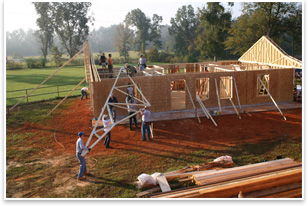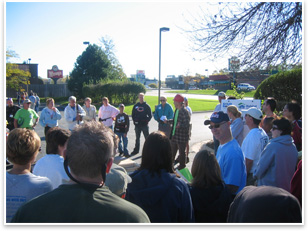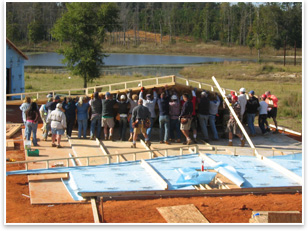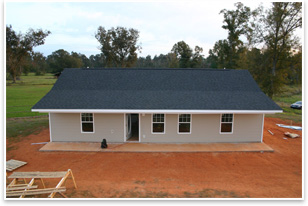Architect-led Habitat Team Builds Five Houses in Seven Days
Blitz-build style creates hope in Bogalusa, La.
by Heather Livingston
Contributing Editor
 How do you . . . volunteer your professional services to make a near-immediate difference for a community in need? How do you . . . volunteer your professional services to make a near-immediate difference for a community in need?
Summary: Mark Eric Benner, AIA, recently led an all-volunteer building team to Bogalusa, La. to construct five homes for Habitat for Humanity. Relying on the efficiencies enabled by BIM, Solid Rock Carpenters was able to erect the five needed homes in only seven days.
 Building for Habitat for Humanity can be both a life-affirming experience and an exercise in aggravation. Depending on the Habitat chapter and the build location, projects can move with expediency or—in rare cases—drag on for years. This situation led Solid Rock Carpenters (SRC), a nonprofit group that works to provide housing for those in need, to take a new approach to Habitat projects, says volunteer Mark E. Benner, AIA, principal of Mark Eric Benner Architects Ltd. Located in Glenview, Ill., SRC now practices the “Blitz Build” style, in which a group of volunteers begins and completes a Habitat for Humanity home in one fell swoop, design work aside. Building for Habitat for Humanity can be both a life-affirming experience and an exercise in aggravation. Depending on the Habitat chapter and the build location, projects can move with expediency or—in rare cases—drag on for years. This situation led Solid Rock Carpenters (SRC), a nonprofit group that works to provide housing for those in need, to take a new approach to Habitat projects, says volunteer Mark E. Benner, AIA, principal of Mark Eric Benner Architects Ltd. Located in Glenview, Ill., SRC now practices the “Blitz Build” style, in which a group of volunteers begins and completes a Habitat for Humanity home in one fell swoop, design work aside.
Building frustration
“The time it takes to build a Habitat home really varies from place to place,” Benner explains. “They can get some done in a fairly regular schedule, but there are others that languish for years. That was the frustration [SRC] felt in the early years, where they were going back year after year, working on the same project, and just making nominal progress.”
 With more than 1,000 volunteers, Solid Rock is a formidable building entity. Since they began building Habitat homes following 2005’s Hurricane Katrina, SRC has helped provide housing to more than 70 families. In June 2007, 50 volunteers traveled to Franklinton, La., where they built two houses over 10 days and began work on a third. Determined to better its outcome, SRC in November again took 50 volunteers to nearby Bogalusa, La. There, in only seven days, the SRC team built five new homes, and completed the third house in Franklinton. With more than 1,000 volunteers, Solid Rock is a formidable building entity. Since they began building Habitat homes following 2005’s Hurricane Katrina, SRC has helped provide housing to more than 70 families. In June 2007, 50 volunteers traveled to Franklinton, La., where they built two houses over 10 days and began work on a third. Determined to better its outcome, SRC in November again took 50 volunteers to nearby Bogalusa, La. There, in only seven days, the SRC team built five new homes, and completed the third house in Franklinton.
According to Benner, what enables the success of the SRC team is its advanced preparation and coordination. Prior to traveling to the site for the build days, 250 volunteers came together in the preceding months and weeks to precut, layout, and build all the walls and building components, shrink-wrapping them into neat packages for on-site assembly.
 Building on BIM Building on BIM
To maximize efficiencies, Benner believes that the use of the building information modeling (BIM) software was critical: “The ArchiCAD models enabled me to quickly and easily generate all the construction documents to be utilized by a largely unskilled workforce, while also helping to coordinate material delivery and construction sequencing to speed up the process … Our ability to provide perspective visualization and shop-drawing-level detail enabled a largely novice volunteer force to understand the components they were building and how they would eventually fit together when assembled.”
Although the homes necessarily share similarities to achieve efficiency, they are not identical. “These are simple homes, and the CAD portion of the project was primarily an effort of coordination and logistics,” Benner says. “As is typical, the benefits of computer aided design and BIM are truly realized under conditions of change. Our production package comprised a variety of home configurations, including a three- and a four-bedroom package. The mix was in flux within one week of our production ‘build days,’ affecting our material quantities and destination locations. The powerful analysis tools allowed us the flexibility to respond to our changing production package.”
 Clearly passionate about what they do, SRC raises a considerable amount of money to cover the cost of materials and shipping for Habitat projects. For the five new houses and the sixth completed from the June trip, SRC raised approximately $100,000, according to Benner. The necessary design and other professional services that would normally require additional funds are provided pro bono by qualified SRC volunteers, and volunteers pay their own travel expenses to and from the construction site. Clearly passionate about what they do, SRC raises a considerable amount of money to cover the cost of materials and shipping for Habitat projects. For the five new houses and the sixth completed from the June trip, SRC raised approximately $100,000, according to Benner. The necessary design and other professional services that would normally require additional funds are provided pro bono by qualified SRC volunteers, and volunteers pay their own travel expenses to and from the construction site.
| 

 How do you . . .
How do you . . .

 Building on BIM
Building on BIM Clearly passionate about what they do, SRC raises a considerable amount of money to cover the cost of materials and shipping for Habitat projects. For the five new houses and the sixth completed from the June trip, SRC raised approximately $100,000, according to Benner. The necessary design and other professional services that would normally require additional funds are provided pro bono by qualified SRC volunteers, and volunteers pay their own travel expenses to and from the construction site.
Clearly passionate about what they do, SRC raises a considerable amount of money to cover the cost of materials and shipping for Habitat projects. For the five new houses and the sixth completed from the June trip, SRC raised approximately $100,000, according to Benner. The necessary design and other professional services that would normally require additional funds are provided pro bono by qualified SRC volunteers, and volunteers pay their own travel expenses to and from the construction site.